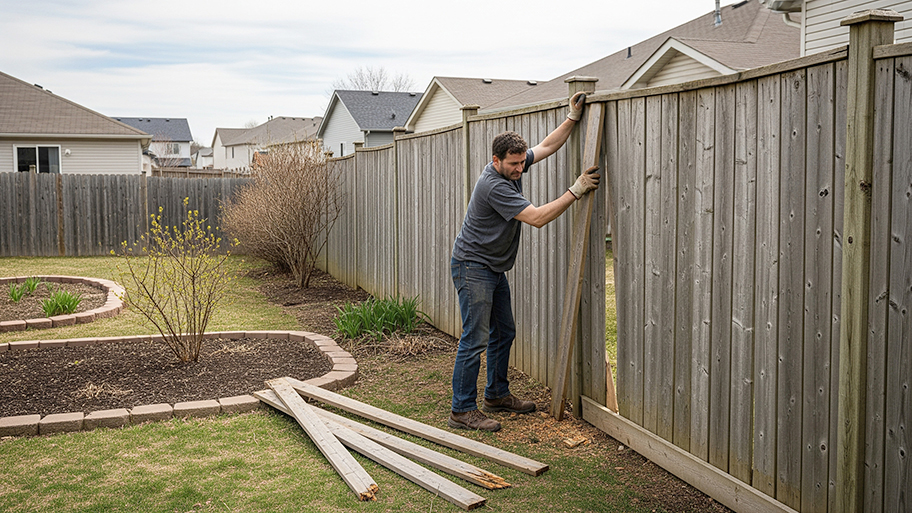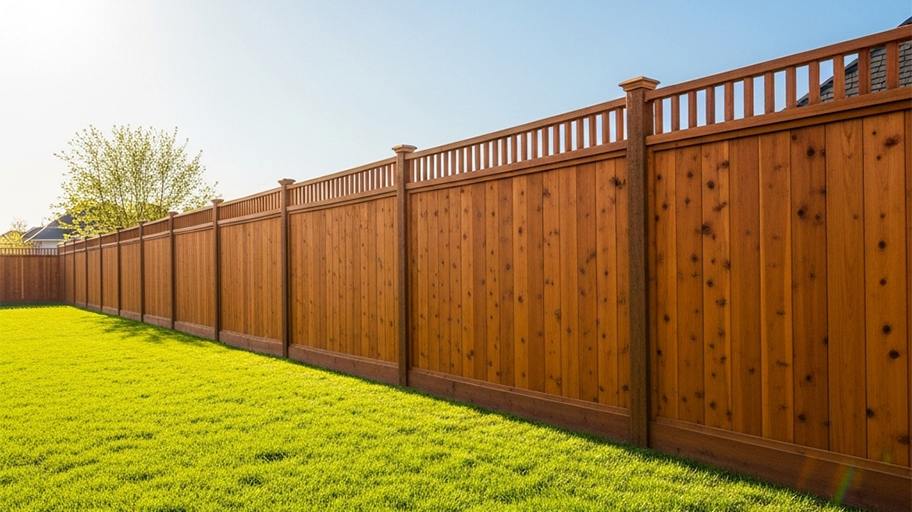
Installing a redwood fence costs around $6,300, though several factors, such as size, landscaping, and permits, can impact the price.
You can clean and restore your cedar fence with a good pressure wash, followed by a new layer of stain


There’s nothing like the rich color and fragrant aroma of a cedar fence—but, like any other fence, it’s sure to get dirty every once in a while. Don’t stress, though: you can clean it up and restore it safely by following these steps.
Before you get to washing, don your gardening gloves and remove any stray plants that might be creeping up your cedar fence. This will give you the best view of the fence’s entire surface so you don’t miss any spots.
Using a pressure washer is the easiest (and most satisfying) way to remove years of grime from your wood fence. If you don’t have one, you can hire a local pressure washing contractor. Alternatively, the cost to rent a pressure washer ranges from $35 to $175 per day.
Start by using 500 to 800 pounds (of pressure) per square inch (psi) with a 25-degree nozzle tip. Adjust the pressure as needed up to 1,500 psi, as anything beyond this may splinter the soft cedar wood.
First, test the pressure washer in an area less visible to get comfortable with the equipment. Then, begin by standing a few feet back from the fence, moving closer if needed. Stay at least 18 inches away to avoid damage.
Note: Make sure you use safety precautions, as the water stream can be hazardous. Wear rubber gloves, old clothes, and safety glasses. If a neighbor's yard is on the other side of the fence, mind their petunias and patio furniture.
Keeping the nozzle horizontal, start at the top of the fence and work to the bottom using long, sweeping motions that follow the grain.
Note: Be careful not to keep the spray in one spot for too long, as this might damage your cedar fence.
After you finish pressure washing, let the cedarwood dry for at least 24 hours before moving to the next step.
Inspect your cedar fence, repairing or replacing any panels as needed. If you see any nails sticking out, hammer them back in place.
For more extensive damage, call a local wood fence repair contractor. Most fence repairs cost between $300 and $800, so you may have to budget a little extra for this task.
Despite its superior ability to resist rotting and warping, cedarwood fades to a grayish color over time. Fret not, though: with a little stain, you can restore a faded wood fence to its former glory.
Use a four-inch paintbrush to apply stain to the main boards and a two-inch (or smaller) brush between the boards. A paint roller is another option, but brushing is the best way to ensure the stain gets in the wood grain and small areas.
The first coat will require quite a bit of stain as much of it will be absorbed by the bare wood. Let it dry fully before applying a second coat, which won't soak in as much. Once the second coat is dry, stand back, grab your beverage of choice, and enjoy your beautifully restored cedar fence.
If you put the “power” in “power washer” and you’re no stranger to a paintbrush, you can save a lot by DIY-ing this job.
Stain costs around $24 per gallon, plus about $7 for paintbrushes. Keep in mind that one gallon of stain will cover about 160 square feet of fence. Staining your fence professionally costs between $750 and $4,250, including materials and prep work.
Renting a power washer can cost anywhere from $35 to $175 per day, whereas the average price to do it professionally goes for around $300. This will be a good area to invest in the pros, as inexperience with a pressure washer can result in injury and damage to your cedarwood.
If you’re not into the pressure-washer idea, there’s a way around it —but you’ll need additional patience and elbow grease. Don’t skip the wash altogether, as it’s essential to clean cedar before staining. Otherwise, the stain might not adhere properly.
Here’s how to clean old fence boards without pressure washing:
Spray the fence down with distilled white vinegar to take care of mold and mildew (dilute with water for fences that aren’t as soiled)
Scrub with a little bit of baking soda to loosen the dirt
Spray the fence down with your hose and allow it to dry
There are also commercial cleaners out there that can help destroy mold, dirt, and mildew stains. If you go this route, be sure to read the label carefully to ensure it’s cedar-safe.
Unfortunately, excessively rotted and worn cedar fences aren’t salvageable with a simple pressure wash and stain. If it’s the end of the road for your fence, consider waiting until the fall or winter to install a new one. Crews will be less busy and prices are often much lower.
As for choosing the best fence for your yard, consider variables like privacy, maintenance, and (of course) cost. Once you find what works best for you and your family, you can destroy, rebuild, and enjoy.
From average costs to expert advice, get all the answers you need to get your job done.

Installing a redwood fence costs around $6,300, though several factors, such as size, landscaping, and permits, can impact the price.

An electric fence is an effective way to keep animals in your yard. Learn how much different electric fences cost, in this guide.

Shadowbox fencing can boost your home’s appearance and privacy. Use this guide to learn how much it costs to install a shadowbox fence based on factors like material, length, and height.

Fence removal costs are highly variable, depending mainly on the size and type of fence. Read on and learn why labor will always be your biggest spend.

Fences make great neighbors. Here's how to choose the right types of fences for privacy and security in your yard.

Did you know you can extend the height of your fence for more privacy? Read on to learn how to make a fence taller.